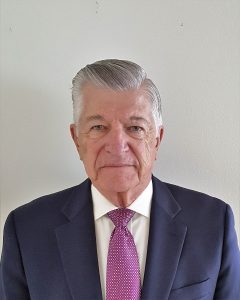Hometown: Osprey, Florida
Professional interests: Astronautics, space technology
Dr. Yarymovych is President of Sarasota Space Associates, an Aerospace Consultancy. In February 1998, after a 20-year industry career, retired from Boeing and its predecessor Rockwell International, where he held various positions as Vice President responsible for engineering and technology on the Space Shuttle, B1 Aircraft, Missile Defense, GPS and classified programs. During his government career he was Director for Flight Systems on NASA’s Apollo Program, Technical Director of the USAF Manned Orbital Laboratory, Chief Scientist of the U.S. Air Force, Deputy Assistant Secretary of the USAF for R&D. He also served as Assistant Administrator of the Energy Research and Development Administration (ERDA). He was Chairman of the NATO Research and Technology Board, and prior to that was Chairman of NATO Advisory Group for Aerospace Research and Development (AGARD).
He is a member of the National Academy of Engineering, a Member of the Air Force Studies Board and the Air Force Scientific Advisory Board, a Member of the International Academy of Astronautics and served as its President from 1996 to 2003, Honorary Fellow of the American Institute of Aeronautics and Astronautics, where he served as President 1982 -1983 and Fellow of the American Astronautical Society. He is a four-time recipient of the Air Force Exceptional Civilian Service Award, the ERDA Distinguished Service Award, the AIAA Distinguished Service Award, the NATO RTO von Karman Medal and the IAA von Karman Award. He is a member of the Cosmos Club, the French Air and Space Academy, and the National Ukrainian Academy of Sciences.
Why did you decide to join the Shevchenko Scientific Society?
At the start of my graduate studies in 1955 at Columbia University I became quite active in the Ukrainian students community. At that time as an aeronautical engineer, I think that I was the only Ukrainian with an engineering background, although I was working alongside with Volodymyr Petryshyn as a mathematician, who also eventually became a member of NTSh. I was President of the group, which eventually became the one that sponsored the Ukrainian Studies Chair at Harvard. During that time in New York, I became interested in the NTSh and participated in several lectures and gave some talks of my own. I was elected to be Full member of the Society.
What do you value about membership in the Society?
I was born in Poland, and lived only for two years in Lviv, after the Soviets left in the early ‘40s. My entire Ukrainian language and culture education consisted of two years in a Ukrainian school and whatever my parents taught me. My father, also an engineer, was quite well known during the times in Lviv and later upon emigration to New York. It is because of my father’s influence and guidance that I became involved with the NTSh. I cannot recall that there was a particular event that prompted me to “join” the Society. It was just there. Since childhood I was interested in space technology, and I gave a few talks at the Society. To me, at that time NTSh was the only scientific outlet in the Ukrainian environment in downtown New York. Later I became aware of the UVAN, which promptly also made me a full member of that organization.
How did your interest in Ukrainian culture and society influence your career path?
My career path was influenced by my interest in space technology and had nothing to do with Ukrainian culture. As an aerospace engineer, later dubbed a ”rocket scientist,” I was interested in the work that was being performed by Ukrainian engineers in the USSR. Of course, later I became much more interested and aware of Soviet/Ukrainian projects, especially when I started working with the US Air Force. In all of my professional career, I dedicated most of my work to defeating the Soviet Union while trying to differentiate between Ukrainian and Russian scientists.
What are your research interests?
All my research and technical work have been centered on technical leadership in developing space systems and defense against enemy missile attacks. I had the opportunity to go to Ukraine in early 1992, right after Ukraine became independent. I immediately visited the huge Soviet missile organization in Dnipropetrovsk, now Dnipro, where they were still producing the huge SS18 missiles at a very high rate. There I met Leonid Kuchma, who at the time was the General Designer of Yuzhmash (Pivdenmash). He soon left the organization to run for president and was replaced by Stanislav Konyukhov. We began working on a most important project called SeaLaunch using the very large rocket named Zenit from Dnipro. The original chief designer of Yuzhmash was Mikhail Yangel, a Ukrainian designer who was actually competing with Serhiy Korolev, another Ukrainian who designed and launched the first satellite Sputnik, and later put the first man in space. It’s a long story, but suffice to say I was there in the middle of it all. In 1993 I was elected a full member of the Ukrainian National Academy of Sciences.
What career advice would you give for new members of the Shevchenko Scientific Society?
The most important advice I can give to new young members of NTSh is to always follow your dreams, rather than take on a career that initially seems to make you some money. Your dreams will in the end make you rich, if not financially then at least spiritually!

